Are you aware that fire extinguishers must be inspected regularly to ensure they are in good working condition? Most people overlook this important safety measure, but it is crucial in a fire emergency. In this guide, we will discuss how to inspect a fire extinguisher.
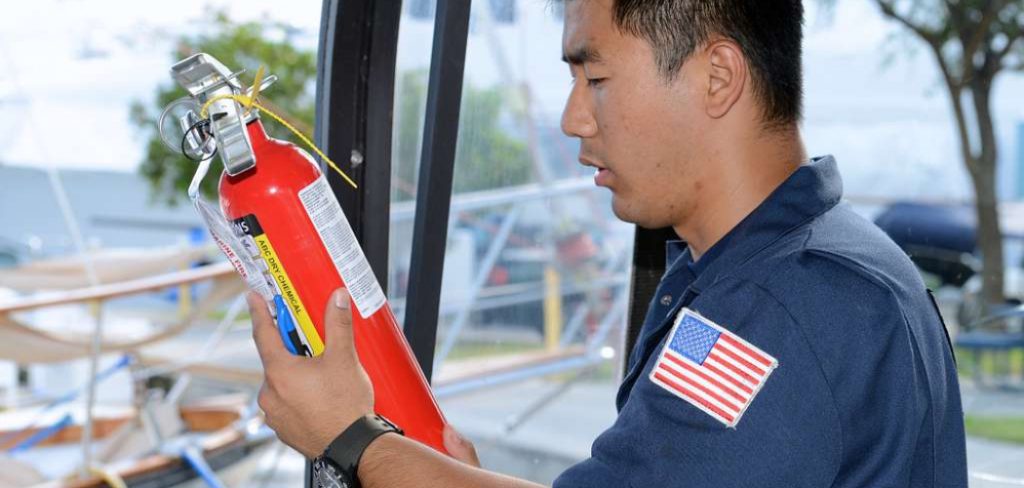
Proper maintenance of fire extinguishers is crucial for ensuring they function correctly when needed. Regular inspections help identify any issues that might prevent an extinguisher from operating efficiently during an emergency.
This guide will walk you through the essential steps to inspect a fire extinguisher, ensuring it is in working condition and compliant with safety standards. Following these steps can contribute significantly to fire safety in your home or workplace.
Why Inspect Your Fire Extinguisher?
Before we dive into the steps of inspecting a fire extinguisher, let’s first understand why it is necessary. Fire extinguishers are vital in preventing small fires from turning into large, uncontrollable blazes.
However, if they are not properly maintained and inspected, they may not function properly when needed. Regular inspections can help identify any issues, such as low pressure or damage to the extinguisher, that may prevent it from working effectively during an emergency.
Moreover, fire codes and regulations require regular inspections of fire extinguishers to ensure compliance with safety standards. Failure to comply with these regulations can result in penalties and fines, but more importantly, it puts people’s lives at risk in case of a fire emergency.
What Will You Need?
To properly inspect a fire extinguisher, you will need the following items:
- A fire extinguisher (of course!)
- Protective gloves and eyewear
- A pressure gauge (specific to the type of extinguisher)
- Visual inspection checklist (can be found online or provided by your local fire department)
Now that we understand the importance of regularly inspecting a fire extinguisher and have all the necessary tools let’s dive into the steps for proper inspection.
10 Easy Steps on How to Inspect a Fire Extinguisher
Step 1. Ensure Accessibility:
First and foremost, make sure the fire extinguisher is easily accessible. It should be located in a visible and unobstructed area to quickly retrieve it in an emergency.
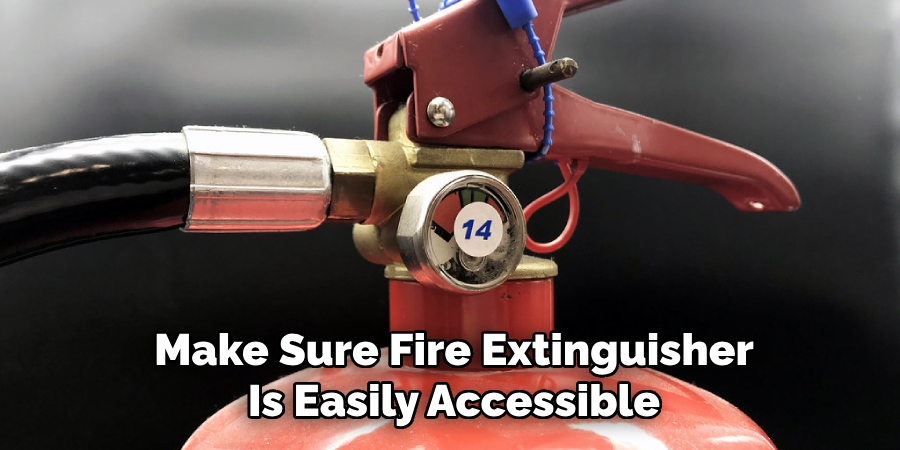
Check that it is mounted at an appropriate height, typically between three and five feet off the ground, depending on local regulations. Ensure that the extinguisher is not blocked by furniture, machinery, or any other objects that could impede access.
Step 2. Check the Pressure Gauge:
The pressure gauge is an essential component that indicates whether the fire extinguisher is adequately pressurized and ready for use. Locate the pressure gauge on the extinguisher and inspect the needle’s position.
The needle should be in the green zone, which signifies that the extinguisher is within the safe operating range. If the needle is in the red zone, it indicates over or under-pressurization. In either case, the extinguisher may not perform correctly and should be serviced or replaced immediately.
Additionally, check for any signs of damage or corrosion on the gauge itself, which could affect its accuracy. If there are any doubts about the gauge’s condition, seek professional assistance to ensure the fire extinguisher’s reliability.
Step 3. Inspect the Physical Condition:
Carefully examine the fire extinguisher’s body for any visible signs of damage, such as dents, punctures, or rust. Physical damage can compromise the integrity of the extinguisher, making it unsafe to use in an emergency.
Pay close attention to the nozzle and hose, ensuring they are free from cracks, blockages, or other deformities. The seal and locking pin should also be intact and secure. This inspection helps confirm that the extinguisher’s discharge path is clear and ready for immediate use.
Step 4. Verify the Label and Instructions:
Ensure that the fire extinguisher’s label is legible and attached securely. The label contains critical information, including operating instructions, classification, and safety warnings.
This information is vital during an emergency when users must act quickly and correctly. If the label is worn, faded, or missing, it should be replaced to maintain the extinguisher’s usability and compliance with safety standards.
Step 5. Check the Weight:
Weigh the fire extinguisher to ensure it has not lost any of its content due to leakage or discharge. Compare the actual weight to the weight listed on the label.
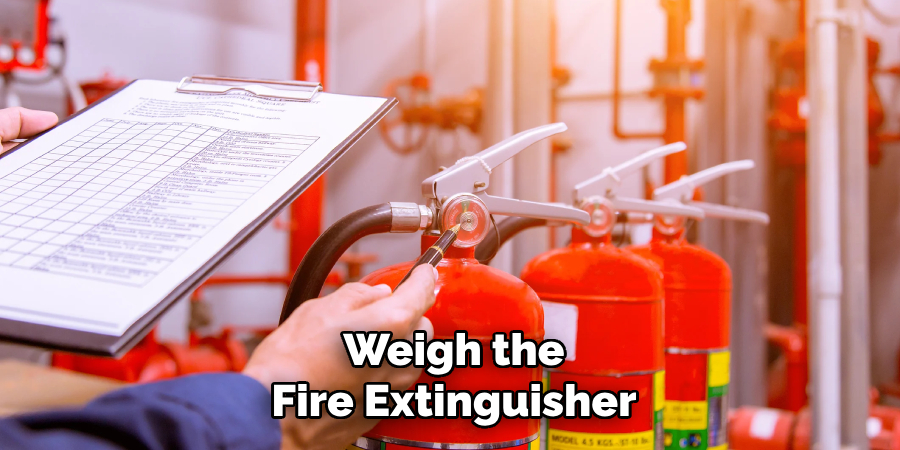
Significant discrepancies might indicate that the extinguisher is no longer fully charged and needs servicing. Maintaining the correct weight is crucial for the extinguisher’s effectiveness.
Step 6. Examine the Tamper Seal:
The tamper seal, a small plastic or metal seal around the safety pin, ensures that the extinguisher has not been used or tampered with.
Check that the seal is intact and not broken. If the seal is missing or damaged, it could indicate that the extinguisher has been discharged or tampered with, and it should be inspected and serviced by a professional.
Step 7. Clean the Extinguisher:
Keep the fire extinguisher clean and free from dust, grease, or any other contaminants that could obscure its label or affect its operation.
Use a soft cloth and mild detergent to wipe down the exterior, ensuring that all markings remain visible and the extinguisher remains ready. Additionally, ensure that the location around the extinguisher is clean and free from any obstructions.
Step 8. Record the Inspection:
Document each inspection by filling out a maintenance log or inspection tag attached to the extinguisher. Include the date of inspection, the inspector’s initials, and any observations or actions taken. This record is essential for tracking the extinguisher’s maintenance history and ensuring compliance with safety regulations.
Step 9. Ensure Proper Placement:
After inspecting, return the fire extinguisher to its designated location, ensuring it is mounted securely and accessible. Confirm that any signage indicating the extinguisher’s location is clear and visible, aiding in quick identification during an emergency.
If the extinguisher was removed from its location for inspection, remember to update the maintenance log or tag with the new location.
Step 10. Schedule Regular Inspections:
Establish a routine inspection schedule, typically monthly, to ensure the fire extinguisher remains in optimal working condition.
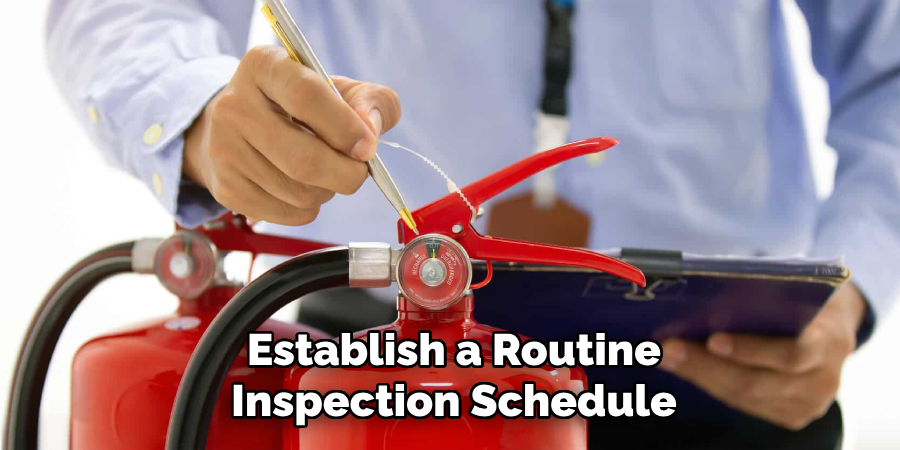
Annual professional inspections and servicing by certified technicians are also recommended to address any technical issues that may not be evident during regular checks. Regular inspections are a proactive measure in maintaining fire safety.
By following these ten easy steps, you can ensure that your fire extinguisher is always in excellent working condition and ready for use in an emergency.
5 Additional Tips and Tricks
- Check the Pressure Gauge: Ensure the needle is in the green zone, indicating the extinguisher is adequately pressurized.
- Examine the Hose and Nozzle: Inspect for any cracks, blockages, or damages that could impede functionality during an emergency.
- Inspect the Locking Pin and Tamper Seal: Ensure the pin is in place and the tamper seal is intact, confirming the extinguisher hasn’t been used or tampered with.
- Look for Visible Signs of Wear and Tear: Check the body of the extinguisher for any dents, corrosion, or leaks that could compromise its effectiveness.
- Review the Last Inspection Date: Verify that regular maintenance checks are up-to-date by looking at the inspection tag attached to the extinguisher. Regular inspections are crucial for optimal performance.
With these additional tips, you can have peace of mind knowing that your fire extinguisher is in good working condition and ready to use in case of an emergency.
5 Things You Should Avoid
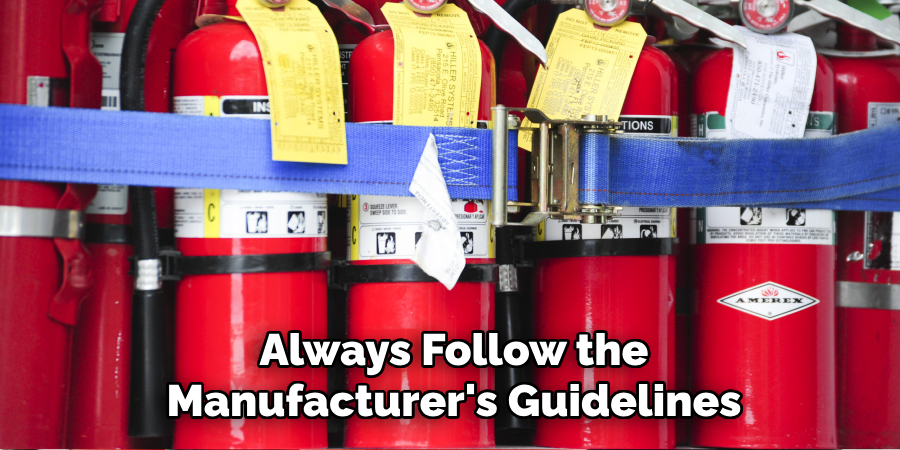
- Ignoring Manufacturer Instructions: Always follow the manufacturer’s guidelines for inspecting and maintaining your specific fire extinguisher model. Deviating from these instructions can lead to improper handling and potential malfunctions.
- Using the Wrong Tools: Employing inappropriate tools can damage the extinguisher parts, such as the nozzle or hose. Always use the tools recommended by the manufacturer to avoid unnecessary damage.
- Neglecting to Wear Protective Gear: Inspecting a fire extinguisher without protective gear can be dangerous, especially if there is any risk of pressurized discharge. Make sure to wear gloves and safety glasses during the inspection.
- Overlooking Minor Damage: Small cracks, dents, or corrosion spots can worsen over time and lead to ineffective performance in an emergency. Do not ignore these seemingly minor issues; address them promptly.
- Skipping Regular Inspections: Fire extinguishers require regular maintenance checks to ensure they remain operational. Skipping these checks can compromise the safety of your environment and violate fire safety regulations. Make it a habit to conduct inspections at the recommended intervals.
By avoiding these common mistakes, you can ensure your fire extinguisher is always in top condition and ready to be used during an emergency.
Conclusion
How to inspect a fire extinguisher is a crucial aspect of maintaining a safe environment.
By adhering to the outlined tips and tricks, you can ensure that your fire extinguisher is always in optimal working condition and ready for use in case of an emergency.
Regular inspections, as per the manufacturer’s guidelines, coupled with a thorough examination of potential wear and tear, can prevent malfunctions and enhance the extinguisher’s effectiveness.
Avoiding common pitfalls such as ignoring minor damage or using the wrong tools further contributes to the reliability of this essential safety device.
In the end, diligent inspection practices not only comply with safety regulations but also provide peace of mind, knowing you are well-prepared to handle fire-related emergencies.
About
Safety Fic is a distinguished figure in the world of Diy design, with a decade of expertise creating innovative and sustainable Diy solutions. His professional focus lies in merging traditional craftsmanship with modern manufacturing techniques, fostering designs that are both practical and environmentally conscious. As the author of diy, Safety Fic delves into the art and science of Safety Fic-making, inspiring artisans and industry professionals alike.
Education RMIT University
(Melbourne, Australia) Associate Degree in Design (Safety Fic) Focus on sustainable design, industry-driven projects, and practical craftsmanship. Gained hands-on experience with traditional and digital manufacturing tools, such as CAD and CNC software.
Nottingham Trent University
(United Kingdom) Bachelor’s in diyfastly.com and Product Design (Honors) Specialized in product design with a focus on blending creativity with production techniques. Participated in industry projects, working with companies like John Lewis and Vitsoe to gain real-world insights.
Publications and Impact
In diy, Safety Fic his insights on indoor design processes, materials, and strategies for efficient production. His writing bridges the gap between artisan knowledge and modern industry needs, making it a must-read for both budding designers and seasoned professionals.
